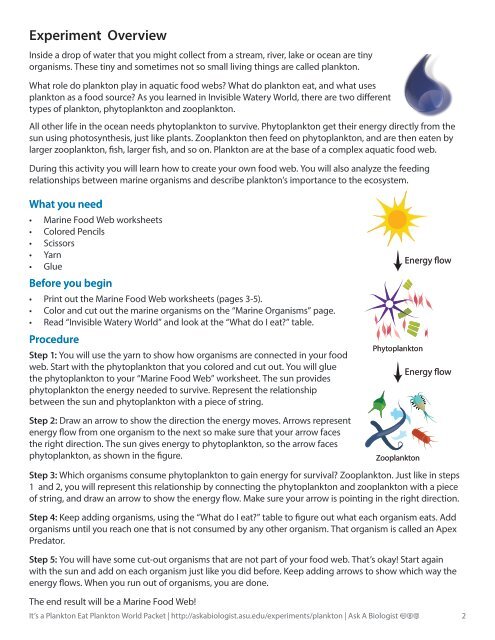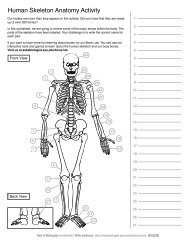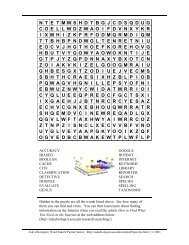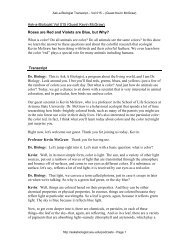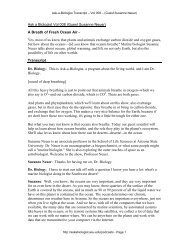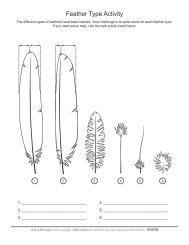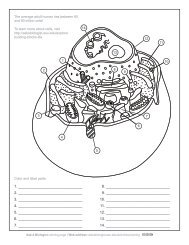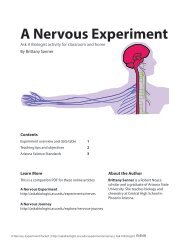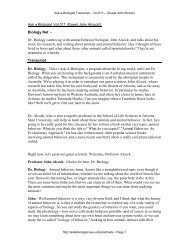Download PDF - Ask A Biologist
Download PDF - Ask A Biologist
Download PDF - Ask A Biologist
- No tags were found...
Create successful ePaper yourself
Turn your PDF publications into a flip-book with our unique Google optimized e-Paper software.
Experiment OverviewInside a drop of water that you might collect from a stream, river, lake or ocean are tinyorganisms. These tiny and sometimes not so small living things are called plankton.What role do plankton play in aquatic food webs? What do plankton eat, and what usesplankton as a food source? As you learned in Invisible Watery World, there are two differenttypes of plankton, phytoplankton and zooplankton.All other life in the ocean needs phytoplankton to survive. Phytoplankton get their energy directly from thesun using photosynthesis, just like plants. Zooplankton then feed on phytoplankton, and are then eaten bylarger zooplankton, fish, larger fish, and so on. Plankton are at the base of a complex aquatic food web.During this activity you will learn how to create your own food web. You will also analyze the feedingrelationships between marine organisms and describe plankton’s importance to the ecosystem.What you need• Marine Food Web worksheets• Colored Pencils• Scissors• Yarn• GlueBefore you begin• Print out the Marine Food Web worksheets (pages 3-5).• Color and cut out the marine organisms on the “Marine Organisms” page.• Read “Invisible Watery World” and look at the “What do I eat?” table.ProcedureStep 1: You will use the yarn to show how organisms are connected in your foodweb. Start with the phytoplankton that you colored and cut out. You will gluethe phytoplankton to your “Marine Food Web” worksheet. The sun providesphytoplankton the energy needed to survive. Represent the relationshipbetween the sun and phytoplankton with a piece of string.Step 2: Draw an arrow to show the direction the energy moves. Arrows representenergy flow from one organism to the next so make sure that your arrow facesthe right direction. The sun gives energy to phytoplankton, so the arrow facesphytoplankton, as shown in the figure.Energy flowPhytoplanktonEnergy flowZooplanktonStep 3: Which organisms consume phytoplankton to gain energy for survival? Zooplankton. Just like in steps1 and 2, you will represent this relationship by connecting the phytoplankton and zooplankton with a pieceof string, and draw an arrow to show the energy flow. Make sure your arrow is pointing in the right direction.Step 4: Keep adding organisms, using the “What do I eat?” table to figure out what each organism eats. Addorganisms until you reach one that is not consumed by any other organism. That organism is called an ApexPredator.Step 5: You will have some cut-out organisms that are not part of your food web. That’s okay! Start againwith the sun and add on each organism just like you did before. Keep adding arrows to show which way theenergy flows. When you run out of organisms, you are done.The end result will be a Marine Food Web!It’s a Plankton Eat Plankton World Packet | http://askabiologist.asu.edu/experiments/plankton | <strong>Ask</strong> A <strong>Biologist</strong> 2


